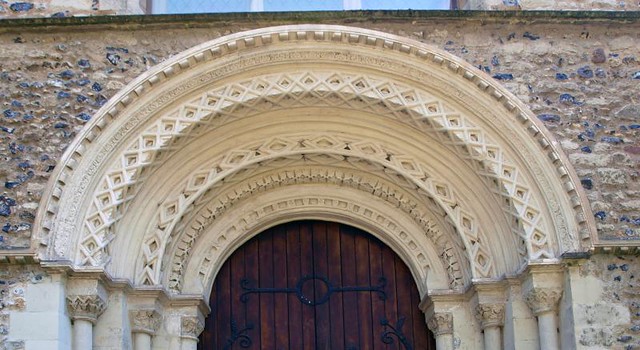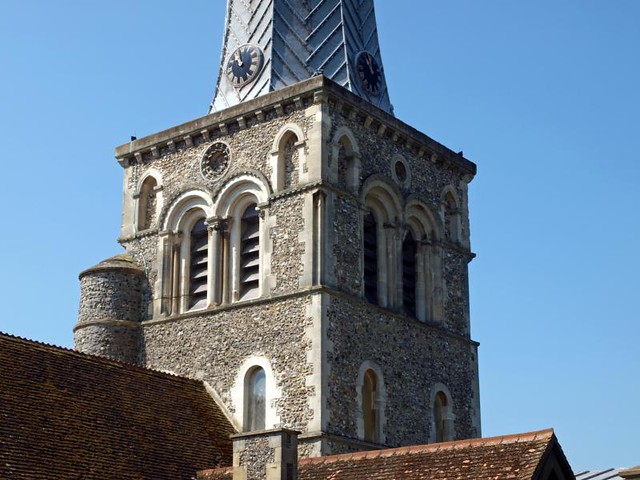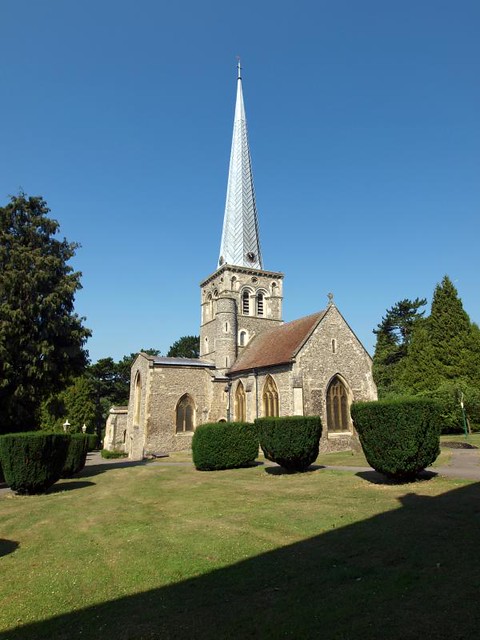I would love to be able to ask the incumbent why, when similar town churches such as Tring, Berkhamstead and even the shit hole that is Sawbridgeworth are all open, it is deemed necessary to keep this church locked. I would rant but it seems pointless - it seems to me that the mindset of a parish such as this that decides to keep its church locked is too far embedded in stupidity to be moved to a more enlightened position. And as an after thought can I shake them by the lapels or is that no longer allowed?
ST MARY. A large church essentially Norman, the only one in the county with the exception of St Albans. Nave and aisles, transepts, crossing tower, chancel, and a small room N of the chancel. The outer walls of flint are all C12, though windows have in the C14 and C15 been enlarged. The earliest part is the relatively low chancel. This seems to date from c. 1150 and is (a rarity in England) rib-vaulted. The ribs and transverse arches have the simplest roll mouldings and rest on wall shafts with scalloped capitals. The narrow room to the N (had it originally an apsidal E end, or was it a sacristy?) is also rib-vaulted. The chancel N window is Norman with double nook-shafts. The transepts and nave were built after the chancel. The nave can hardly be earlier than c. 1175. It has six bays with circular piers. with shallow bases and capitals of many varieties or ornamented scalloping. Little stylized leaves occur and also the so called water-leaf motif. The arches are simply of two steps. The clerestory is contemporary, a rarity. The windows have nook-shafts inside, and a billet-frieze runs all along the outside and around the window arches. The W end of the nave has a doorway of two orders with zigzag and leaf motifs in the voussoirs. The crossing tower is extremely simple on the lower stage, but opens in large shafted twin windows on the upper stage with decorated voussoirs. The staircase turret on the SE is circular in its upper stages. The tower is crowned by a fine big leaded spire rising to nearly 200 ft. In the S transept the W window is also Norman. Otherwise the windows are mostly Perp, except for those in the S wall of the chancel which are Dec.
On its W side the church faces scenery still completely rural. The E end lies below the High Street. The interior of the chancel was repainted in 1888 to Bodley’s designs. - The only early roofs are those of the transepts. They are C15 and have arched braces with traceried spandrels. - STAINED GLASS. S chancel windows, 1858, by Clayton & Bell; S aisle, 1870, by A. Gibbs. - PLATE. Covered Chalice, 1563. - MONUMENTS. Brass (W end s aisle) to Robert Albyn and wife, very good work of the late C14. - Sir Astley Paston Cooper d. 1841, Neo-Gothic epitaph by S. Manning.
Hemel Hempstead. Very much alive and still growing is this market town, whose houses stretch for a mile and more down to the River Gade, where it had flourishing mills in Saxon times; the Conqueror’s Domesday mentions the delicious eels found in the river here.
To this ancient importance it owes its church, a majestic example of Norman architecture, raised on land belonging to Thomas Becket, with Roman bricks among its flint rubble. The only additions to it in 800 years have been two medieval porches and the 19th-century vestries, though the exquisite leaded spire, rising to 200 feet on the central tower, may not have been built till the 13th or 14th century. It is this shining spire which draws us from the country round and guides us as we climb the narrowing street, glimpsing weathered roofs through the deep archways breaking the line of shops, and seeing through one archway the wooden balcony from which men have watched for 300 years the comings and goings in the courtyard of the King’s Arms.
We come to the church by the town hall, behind which it stands in a churchyard so full of flower-beds, with a greenhouse here and seats there, that it looks, as a churchyard should, like a public garden. Grouped round the massive central tower are two transepts, a nave with two aisles, and a vaulted chancel with a little chamber opening out of it, one of the earliest sacristies. All this is the work of the Normans, whose four massive tower arches and great arcades, all deeply carved, make a grand and dignified array. On one of the capitals of their beautiful west doorway a quaint Adam struggles with the serpent while Eve stands by with staring eyes. Some of the carving round this doorway was added two or three centuries later, and the font’s Norman simplicity has tempted a carver nearer our own day to spoil it with his little figures. The Norman clerestory lights up the plain nave roof, 500 years old like the more handsome transept roofs. The chancel roof should be noted; it is one of the finest examples of Norman ribbed vaulting.
We may climb up the steps of the tower, pulling ourselves up by niches cut to help climbers centuries ago, for it is a steep way, but worth it to see the great cylinder studded with short spikes, like an old barrel organ, which has been playing eight tunes as clock chimes since 1761. Other treasured possessions of the church are an edition of Foxe’s Book of Martyrs published in 1610, a 400-year-old chest, a medieval stone coffin, an Elizabethan chalice, and perfect registers back to the opening of Queen Elizabeth I’s reign. One of the bells first rang out in that reign, and four more were made in Stuart days. The big brass portrait of Margaret Albyn is much older, showing her husband in armour of the end of the 14th century and her inscription written in old French. Another inscription mourns Richard Combe and his son who died in 1692 “the father’s first, the family’s last”; the ruined porch with a room over it just outside the churchyard is a fragment of their home.
Here is a memorial of Sir Astley Cooper, John Hunter’s pupil and the most eminent surgeon of his day, who came to rest at Hemel Hempstead after a strenuous and successful life. He once said that if he laid his head on the pillow at night without having dissected something during the day he would think that day lost. Once he had a fee of 1000 guineas tossed to him in a nightcap by a grateful patient; but it was a small operation on George IV which gained him his baronetcy. He doctored horses as well as kings, bringing many a poor worn-out animal to recover in his grounds at Gadesbridge.
Near the church are two delightful cottages of brick and timber, 300 years old, known for some reason as Henry’s Banqueting Hall. Their plaster overmantels are sprinkled with Tudor roses, crowns, and fleurs-de-lys. Lockers, the house on Bury Hill with an Elizabethan wing, has plaster ceilings liberally sprinkled with lions and unicorns, a king’s head, and the royal arms.
Two great churchmen have been born in this old country town, one much admired by James I, the other openly disapproving of Charles II. Richard Field was born here in 1561 and was for a long time rector of Burghclere in Hampshire, his sermons drawing crowds and leading King James to remark: “This is indeed a field for God to dwell in.” His brass portrait is on his grave in St George’s Chapel, Windsor, where he occasionally preached to the king, who exclaimed on hearing of his death: “I should have done more for that man.” Nicholas Stratford, a tailor’s son born here in 1663, preferred to resign his wardenship of the collegiate church of Manchester rather than approve of Charles II’s policy, but the Revolution brought him back into favour as Bishop of Chester. He was a notable reformer, and established a school for poor boys at Chester, where he lies in the cathedral.
About three-quarters of a mile north of the town at Piccotts End, a hall house, are some remarkable 14th-century wall-paintings.
Domesday Book mentions the mills of Hemel Hempstead, and there is a paper mill at Apsley End which gained a 19th-century reputation by supplying the Government with the paper for our early postage stamps. One of the Dickinsons, its owners, discovered how to make paper in a continuous sheet, and so made possible the enormous editions of our daily newspapers; and the mill is also notable because of its association for a whole lifetime with one of the most remarkable men of last century, Sir John Evans. He was one of the partners of the mills, which were founded by his uncle, and it was in his spare time that he did the marvellous work which made him famous as an archaeologist. We come upon him at Abbot’s Langley, where he lies.
The New Town which has so greatly changed the character of the neighbourhood was begun in 1949 and is now inhabited by a population of many thousands and in addition there is a considerable industrial area. One of the most pleasing features, perhaps, i
the shopping centre with arcaded shop-fronts of simple design and flats above.
To this ancient importance it owes its church, a majestic example of Norman architecture, raised on land belonging to Thomas Becket, with Roman bricks among its flint rubble. The only additions to it in 800 years have been two medieval porches and the 19th-century vestries, though the exquisite leaded spire, rising to 200 feet on the central tower, may not have been built till the 13th or 14th century. It is this shining spire which draws us from the country round and guides us as we climb the narrowing street, glimpsing weathered roofs through the deep archways breaking the line of shops, and seeing through one archway the wooden balcony from which men have watched for 300 years the comings and goings in the courtyard of the King’s Arms.
We come to the church by the town hall, behind which it stands in a churchyard so full of flower-beds, with a greenhouse here and seats there, that it looks, as a churchyard should, like a public garden. Grouped round the massive central tower are two transepts, a nave with two aisles, and a vaulted chancel with a little chamber opening out of it, one of the earliest sacristies. All this is the work of the Normans, whose four massive tower arches and great arcades, all deeply carved, make a grand and dignified array. On one of the capitals of their beautiful west doorway a quaint Adam struggles with the serpent while Eve stands by with staring eyes. Some of the carving round this doorway was added two or three centuries later, and the font’s Norman simplicity has tempted a carver nearer our own day to spoil it with his little figures. The Norman clerestory lights up the plain nave roof, 500 years old like the more handsome transept roofs. The chancel roof should be noted; it is one of the finest examples of Norman ribbed vaulting.
We may climb up the steps of the tower, pulling ourselves up by niches cut to help climbers centuries ago, for it is a steep way, but worth it to see the great cylinder studded with short spikes, like an old barrel organ, which has been playing eight tunes as clock chimes since 1761. Other treasured possessions of the church are an edition of Foxe’s Book of Martyrs published in 1610, a 400-year-old chest, a medieval stone coffin, an Elizabethan chalice, and perfect registers back to the opening of Queen Elizabeth I’s reign. One of the bells first rang out in that reign, and four more were made in Stuart days. The big brass portrait of Margaret Albyn is much older, showing her husband in armour of the end of the 14th century and her inscription written in old French. Another inscription mourns Richard Combe and his son who died in 1692 “the father’s first, the family’s last”; the ruined porch with a room over it just outside the churchyard is a fragment of their home.
Here is a memorial of Sir Astley Cooper, John Hunter’s pupil and the most eminent surgeon of his day, who came to rest at Hemel Hempstead after a strenuous and successful life. He once said that if he laid his head on the pillow at night without having dissected something during the day he would think that day lost. Once he had a fee of 1000 guineas tossed to him in a nightcap by a grateful patient; but it was a small operation on George IV which gained him his baronetcy. He doctored horses as well as kings, bringing many a poor worn-out animal to recover in his grounds at Gadesbridge.
Near the church are two delightful cottages of brick and timber, 300 years old, known for some reason as Henry’s Banqueting Hall. Their plaster overmantels are sprinkled with Tudor roses, crowns, and fleurs-de-lys. Lockers, the house on Bury Hill with an Elizabethan wing, has plaster ceilings liberally sprinkled with lions and unicorns, a king’s head, and the royal arms.
Two great churchmen have been born in this old country town, one much admired by James I, the other openly disapproving of Charles II. Richard Field was born here in 1561 and was for a long time rector of Burghclere in Hampshire, his sermons drawing crowds and leading King James to remark: “This is indeed a field for God to dwell in.” His brass portrait is on his grave in St George’s Chapel, Windsor, where he occasionally preached to the king, who exclaimed on hearing of his death: “I should have done more for that man.” Nicholas Stratford, a tailor’s son born here in 1663, preferred to resign his wardenship of the collegiate church of Manchester rather than approve of Charles II’s policy, but the Revolution brought him back into favour as Bishop of Chester. He was a notable reformer, and established a school for poor boys at Chester, where he lies in the cathedral.
About three-quarters of a mile north of the town at Piccotts End, a hall house, are some remarkable 14th-century wall-paintings.
Domesday Book mentions the mills of Hemel Hempstead, and there is a paper mill at Apsley End which gained a 19th-century reputation by supplying the Government with the paper for our early postage stamps. One of the Dickinsons, its owners, discovered how to make paper in a continuous sheet, and so made possible the enormous editions of our daily newspapers; and the mill is also notable because of its association for a whole lifetime with one of the most remarkable men of last century, Sir John Evans. He was one of the partners of the mills, which were founded by his uncle, and it was in his spare time that he did the marvellous work which made him famous as an archaeologist. We come upon him at Abbot’s Langley, where he lies.
The New Town which has so greatly changed the character of the neighbourhood was begun in 1949 and is now inhabited by a population of many thousands and in addition there is a considerable industrial area. One of the most pleasing features, perhaps, i
the shopping centre with arcaded shop-fronts of simple design and flats above.



No comments:
Post a Comment